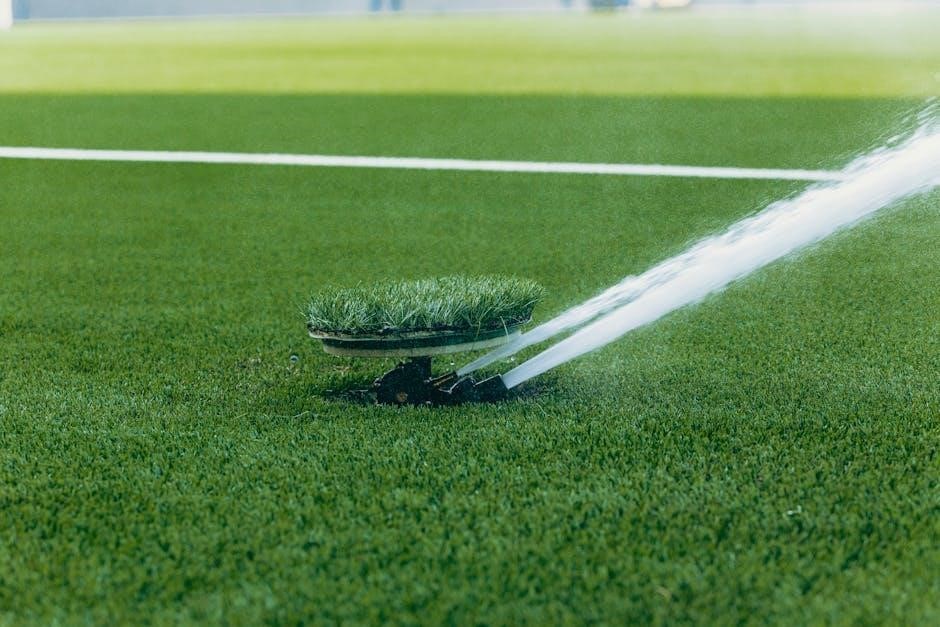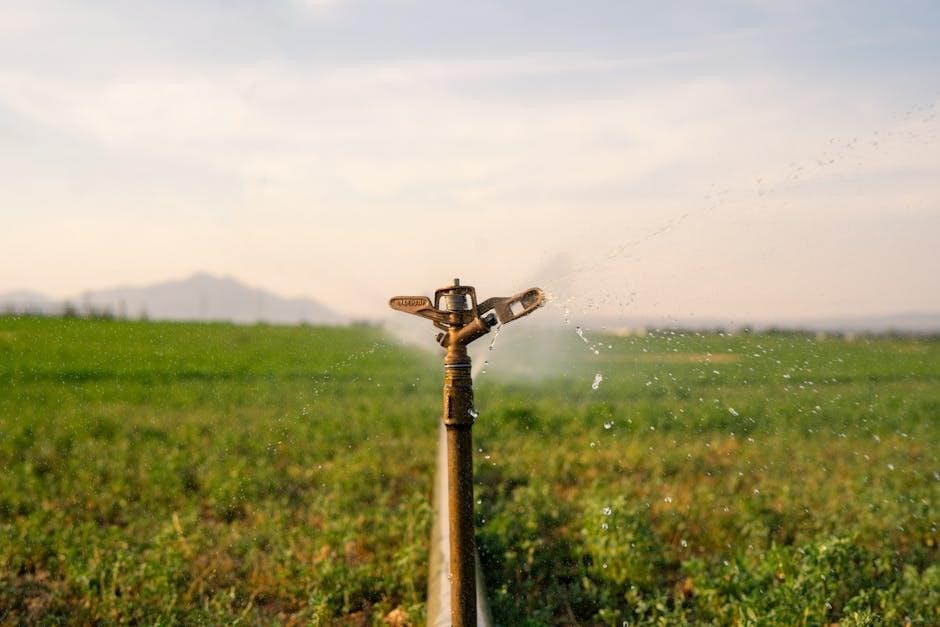Sprinkler irrigation systems are essential for efficient water use in agriculture, addressing groundwater depletion and crop demands․ Proper design ensures optimal water distribution, reducing evaporation and runoff, while advanced technologies like machine learning improve uniformity and energy efficiency, making them sustainable for modern farming․
1․1 Overview of Sprinkler Irrigation Systems
Sprinkler irrigation systems distribute water through a network of pipes and sprinklers, mimicking natural rainfall․ They are versatile, suitable for various crops, vegetables, and field shapes․ These systems are designed to deliver water uniformly, ensuring optimal crop growth while conserving water․ Key factors influencing their design include water availability, soil type, and field layout․ Fixed or solid set systems eliminate the need to move laterals, enhancing efficiency․ Proper design ensures reduced evaporation and runoff, making them a sustainable choice for modern agriculture․
1․2 Importance of Efficient Irrigation Design
Efficient irrigation design is crucial for sustainable agriculture, addressing groundwater depletion and water scarcity․ Properly designed systems minimize evaporation and runoff, ensuring water is used optimally․ They align with crop water requirements, soil types, and field layouts, reducing waste and energy costs․ Advanced designs incorporate automation and uniformity, enhancing crop yields and environmental sustainability․ Efficient systems also reduce operational costs and extend equipment lifespan, making them economically viable and environmentally responsible for modern farming practices․
1․3 Brief History and Evolution of Sprinkler Systems
The concept of sprinkler irrigation dates back to manual watering systems, evolving significantly over time․ Early systems used perforated pipes and basic nozzles, while modern designs incorporate advanced automation and precision engineering․ The introduction of automated controllers and machine learning has enhanced uniformity and efficiency․ Today, sprinkler systems integrate smart technologies, optimizing water use and reducing environmental impact․ This evolution reflects humanity’s ingenuity in addressing agricultural water challenges, ensuring sustainable irrigation practices for future generations․

Key Components of a Sprinkler Irrigation System
A sprinkler irrigation system includes sprinkler heads, nozzles, pipes, fittings, pumps, and controllers․ These components work together to ensure efficient water distribution and system performance․
2․1 Sprinkler Heads and Nozzles

Sprinkler heads and nozzles are critical components, determining water distribution patterns and application rates․ They vary in design, with fixed-angle or adjustable nozzles, to suit different field layouts and crops․ Proper selection ensures uniform water coverage, minimizing evaporation and runoff losses․ The spacing and type of sprinkler heads depend on water pressure, flow rate, and soil type․ Advanced nozzles can reduce drift and improve efficiency, making them essential for modern irrigation systems․ Their performance directly impacts crop yields and water conservation efforts in agricultural settings․
2․2 Pipes and Fittings
Pipes and fittings are essential for distributing water evenly in sprinkler irrigation systems․ They must be durable, resistant to corrosion, and suitable for varying water pressures․ Common materials include PVC, HDPE, and galvanized steel, each offering unique benefits․ Proper sizing ensures minimal friction loss and optimal flow rates․ Fittings like couplers, elbows, and tees enable system flexibility and customization․ Their selection and installation are critical to maintain water pressure and flow uniformity, ensuring efficient irrigation and minimizing energy losses in the system․
2․3 Pumps and Water Source Equipment
Pumps are critical for drawing water from sources like wells, reservoirs, or rivers, ensuring sufficient pressure for sprinkler operation․ Centrifugal and submersible pumps are commonly used, selected based on flow rate, pressure, and system requirements․ Proper pump sizing ensures efficient water delivery without energy waste․ Water source equipment includes intake screens and filtration systems to prevent debris and maintain water quality․ Selecting the right pump and equipment is vital for reliable operation, optimal water distribution, and long-term system performance in sprinkler irrigation․
2․4 Controllers and Automation Systems
Controllers and automation systems are essential for managing sprinkler irrigation operations efficiently․ Modern controllers use sensors and data analytics to optimize water distribution, adjusting for soil moisture, weather, and crop needs․ Automation reduces manual intervention, ensuring precise irrigation schedules and water conservation․ Advanced systems integrate with machine learning to predict water requirements, enhancing uniformity and reducing evaporation losses․ Properly designed automation systems improve resource management, lower energy costs, and increase crop yields, making them a cornerstone of modern sprinkler irrigation design and operation․
Design Considerations for Sprinkler Systems
Designing sprinkler systems requires careful consideration of water availability, soil conditions, and field layout to ensure efficient irrigation, minimize losses, and match equipment to site-specific needs․
3․1 Climate and Weather Patterns
Climate and weather patterns significantly influence sprinkler irrigation system design․ High evaporation rates in arid regions require precise water distribution to minimize losses․ Wind conditions affect spray uniformity, necessitating system adjustments to prevent drift․ Rainfall intensity and frequency also play a role in determining irrigation schedules and water application rates․ Understanding local weather data ensures systems are optimized for specific climatic conditions, enhancing efficiency and reducing environmental impact․ Accurate climate assessments help in selecting appropriate sprinkler types and operational strategies to match varying weather challenges effectively․
3․2 Soil Type and Topography
Soil type and topography significantly influence sprinkler irrigation system design․ Different soils have varying infiltration rates, affecting water application․ Sandy soils may need more frequent irrigation, while clay soils require careful management to prevent waterlogging․ Topography influences water distribution, with slopes potentially causing runoff․ Designing systems that account for these factors ensures efficient water use, prevents waste, and maintains uniformity․ Proper consideration of soil and land features is essential for an effective irrigation system, ensuring optimal water delivery across varied terrains․
3․3 Crop Water Requirements
Crop water requirements are crucial for designing efficient sprinkler irrigation systems․ Different crops demand varying water amounts based on growth stages and climatic conditions․ Understanding these needs ensures precise irrigation scheduling, preventing overwatering or underwatering․ Sprinkler systems must be tailored to deliver water uniformly, matching crop demands while minimizing losses․ Proper design considers crop type, soil moisture levels, and evapotranspiration rates to optimize water application, ensuring healthy plant growth and resource conservation․ Accurate assessment of crop water needs is vital for sustainable irrigation practices․
3․4 Field Shape and Layout
Field shape and layout significantly influence sprinkler irrigation system design․ Square, rectangular, and triangular configurations are common, each affecting water distribution patterns․ Irregular shapes may require adjustments to ensure uniform coverage․ Proper layout planning minimizes interference from obstacles like trees or buildings․ The arrangement of sprinklers and pipes must align with the field’s topography to prevent uneven water application․ Sloped or uneven terrains demand precise placement to avoid runoff or waterlogging․ Efficient field layout ensures optimal water use and minimizes system inefficiencies, enhancing overall irrigation performance and crop yields․
Hydraulic Design of Sprinkler Systems
Hydraulic design ensures efficient water distribution by managing pressure and flow rates, crucial for optimal sprinkler performance and minimizing energy use in irrigation systems․
4․1 Principles of Hydraulic Design
Hydraulic design principles focus on managing water pressure and flow rates to ensure efficient distribution․ Proper pipe sizing and layout minimize energy loss and maximize system performance․ Factors like friction loss, velocity, and pressure regulation are critical․ Advanced techniques, such as machine learning, optimize uniformity and reduce evaporation․ These principles ensure the system delivers water uniformly, maintaining crop health while conserving resources and energy, making it sustainable for agricultural applications․

4․2 Pipe Sizing and Friction Loss Calculation
Pipe sizing and friction loss calculation are critical for ensuring efficient water flow in sprinkler systems․ Proper sizing balances flow rates and pressure distribution, minimizing energy loss․ Friction loss, influenced by pipe material, length, and diameter, is calculated using methods like the Hazen-Williams equation․ Accurate calculations ensure optimal pipe diameter selection, maintaining uniform water distribution and system efficiency․ This step is vital for designing cost-effective and high-performing irrigation systems, addressing crop water requirements and field conditions effectively․
4․3 Pressure Regulation and Distribution
Pressure regulation is essential for maintaining consistent water flow in sprinkler systems․ Proper distribution ensures uniform irrigation across the field․ Pressure-regulating valves and sprinkler nozzles are key components, balancing water pressure to prevent overwatering or underwatering․ Correct pressure management reduces evaporation losses and runoff, enhancing water use efficiency․ Terrain and system design influence pressure distribution, requiring careful planning to ensure optimal performance․ Accurate pressure regulation is vital for achieving uniform water application and maximizing crop yields while conserving water resources effectively․
Water Source and Treatment
Water source and treatment are critical for sprinkler irrigation systems, ensuring water quality and sustainability․ Proper treatment prevents clogging and maintains system efficiency and crop health․
5․1 Identifying Suitable Water Sources
Identifying suitable water sources is crucial for sprinkler irrigation systems․ Surface water, groundwater, and recycled water are common sources․ Assessing water availability, quality, and sustainability ensures system efficiency․ Proper selection prevents depletion and contamination, maintaining crop health and environmental balance․ Regular testing and management of water sources are essential for long-term irrigation system performance and sustainability․
5․2 Water Filtration and Treatment Options
Effective water filtration and treatment are vital for sprinkler irrigation systems to ensure clean and safe water supply․ Common methods include screen filters, sand media filters, and chemical treatments to remove debris and contaminants․ UV systems can disinfect water, while reverse osmosis is used for desalination․ Proper treatment prevents clogging of sprinklers and nozzles, ensuring optimal system performance and crop health․ Regular maintenance of filtration systems is essential to sustain water quality and system efficiency over time․
5․3 Water Quality Management
Water quality management is crucial for maintaining the effectiveness and longevity of sprinkler irrigation systems․ Regular monitoring and testing of water sources help identify contaminants and nutrients․ Implementing conservation practices reduces evaporation and runoff, preserving water resources․ Sustainable irrigation techniques, such as precision agriculture, optimize water use while minimizing environmental impact․ Proper management ensures water remains safe for crops, preventing contamination and maintaining ecosystem balance․ Advanced technologies, like sensors and automation, further enhance water quality control, promoting efficient and responsible irrigation practices․

Irrigation Uniformity and Efficiency
Irrigation uniformity and efficiency are critical for optimal water use․ Factors like wind drift and evaporation affect distribution․ Advanced techniques, such as machine learning, help optimize water application․
6;1 Measuring Uniformity in Sprinkler Systems
Measuring uniformity in sprinkler systems is crucial for assessing water distribution accuracy․ Techniques like catch can tests and sensor arrays are commonly used to evaluate uniformity․ Factors such as sprinkler spacing, nozzle type, and operating pressure significantly impact distribution patterns․ Advanced technologies, including machine learning, are increasingly employed to estimate uniformity metrics precisely․ Ensuring high uniformity minimizes water waste and optimizes crop health, making it a cornerstone of efficient irrigation design and management․
6․2 Factors Affecting Water Distribution Uniformity
Water distribution uniformity in sprinkler systems is influenced by several factors, including wind drift, evaporation losses, and system design․ Sprinkler spacing, nozzle type, and operating pressure also play a significant role․ Additionally, field topography and soil type can affect water distribution patterns․ Climate conditions, such as high winds or extreme temperatures, further impact uniformity․ Addressing these factors is essential to ensure consistent water application, which is critical for optimal crop growth and resource efficiency in agricultural irrigation systems․
6․3 Strategies to Improve System Efficiency
Improving sprinkler system efficiency involves optimizing water use and reducing losses․ Implementing precision irrigation technologies, such as soil moisture sensors and smart controllers, ensures water is applied based on crop needs․ Regular maintenance, including cleaning nozzles and checking for leaks, minimizes water waste․ Additionally, using low-flow sprinklers and pressure-regulating devices helps maintain uniform distribution․ Adopting conservation practices, like drip irrigation integration, further enhances efficiency․ These strategies collectively reduce evaporation, runoff, and energy consumption, promoting sustainable water management in agricultural settings․

Environmental Impact and Sustainability
Sprinkler irrigation systems promote water conservation by reducing evaporation and runoff․ Energy-efficient designs and advanced technologies minimize environmental impact, ensuring sustainable water use for agricultural and landscape needs․
7․1 Water Conservation Techniques
Water conservation is critical in sprinkler irrigation systems to prevent depletion of resources․ Techniques include precision irrigation, drip systems, and smart controllers that optimize water use․ Weather-based sensors and soil moisture monitoring ensure water is applied only when needed․ These methods reduce evaporation and runoff, enhancing efficiency․ Additionally, advanced technologies like machine learning improve uniformity, minimizing waste․ By integrating these strategies, sprinkler systems can significantly lower water and energy consumption, promoting sustainable agricultural practices and environmental stewardship․
7․2 Reducing Evaporation and Runoff
Reducing evaporation and runoff is essential for efficient sprinkler irrigation․ Proper system design, including sprinkler spacing and pressure regulation, minimizes water loss․ Soil moisture monitoring and weather-based sensors help apply water only when needed․ Techniques like drip irrigation and mulching further reduce evaporation․ Additionally, uniform water distribution and avoiding overwatering prevent runoff․ These strategies ensure water is used effectively, conserving resources and enhancing crop yields while maintaining environmental sustainability․

7․3 Energy Efficiency in Irrigation Systems

Energy efficiency in sprinkler irrigation systems is crucial for sustainable farming․ Using variable speed drives and energy-efficient pumps reduces power consumption․ Smart controllers optimize water application, lowering energy use․ Solar-powered systems further cut energy costs and environmental impact․ Regular maintenance ensures optimal performance, reducing wasted energy․ By integrating these technologies, farmers can achieve significant energy savings while maintaining crop health and productivity, promoting eco-friendly irrigation practices․

Maintenance and Troubleshooting
Regular maintenance ensures sprinkler systems operate efficiently․ Inspect and clean sprinkler heads, check pipes for leaks, and ensure proper water flow․ Timely repairs prevent system failures and optimize water distribution․

8․1 Regular Maintenance Practices
Regular maintenance is crucial for the longevity and efficiency of sprinkler irrigation systems․ This includes inspecting and cleaning sprinkler heads to ensure proper water distribution, checking pipes for leaks or blockages, and verifying that all connections are secure․ Additionally, system controllers should be updated and tested to maintain optimal performance․ Seasonal checks, such as winterization to prevent freezing, are also essential․ By adhering to a consistent maintenance schedule, farmers can prevent costly repairs and ensure consistent crop hydration․
8․2 Common Issues and Solutions
Common issues in sprinkler irrigation systems include uneven water distribution, clogged nozzles, and pressure fluctuations․ These problems often arise from poor system design or lack of maintenance․ Solutions involve checking sprinkler alignment, cleaning nozzles regularly, and installing pressure-regulating devices․ Additionally, addressing leaks and ensuring proper pipe sizing can mitigate water loss and inefficiency․ Regular inspections and timely repairs are essential to maintain system performance and prevent crop damage due to inconsistent irrigation․
8․3 Upgrading and Modernizing Systems
Upgrading sprinkler irrigation systems involves integrating advanced technologies like smart sensors and automation․ Modernizing ensures improved water distribution uniformity and energy efficiency․ Replacing outdated components with high-efficiency nozzles and pumps reduces water waste․ Implementing machine learning for real-time monitoring optimizes irrigation schedules․ Retrofitting with solar-powered systems lowers operational costs and environmental impact․ Regular software updates for controllers enhance system adaptability․ These upgrades not only conserve resources but also ensure long-term sustainability and adaptability to evolving agricultural needs․